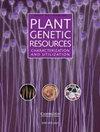Start codon-targeted marker evaluation of genetic relationship and population structure in southern Nigerian fluted pumpkin (Telfairia occidentalis Hook F.) collection
IF 0.7
4区 生物学
Q3 PLANT SCIENCES
Plant Genetic Resources: Characterization and Utilization
Pub Date : 2022-12-01
DOI:10.1017/S1479262123000308
引用次数: 0
Abstract
Abstract Fluted pumpkin (Telfairia occidentalis Hook F.) is an underutilized indigenous leafy vegetable with enormous prospects for food security in sub-Saharan Africa. However, relatively little is known about genetic relationships and population structure in the species. In this study, 32 landraces of fluted pumpkin collected across three southern geographical regions in Nigeria were assessed for genetic diversity and population structure using 8 start codon-targeted (SCoT) makers. The polymorphic information content of the SCoT markers ranged from 0.48 in SCoT36 to 0.94 in SCoT28, with an average of 0.77. Hierarchical cluster dendrogram based on Ward's method and principal component analysis grouped the landraces into four clusters without affiliation to provenance. Overall, the mean values of the population genetic diversity parameters – Nei's gene diversity (H) and Shannon's information index (I) showed values of 0.28 ± 0.01 and 0.43 ± 0.02, respectively, implying a narrow genetic base for the landraces. The result was further corroborated by a very close Nei's genetic distance and identity among populations of the landraces. Furthermore, the south-west population exhibited the higher genetic diversity (H = 0.31 ± 0.02 and I = 0.45 ± 0.03). Population structure analysis inferred three subpopulations for the accessions with varying degrees of allelic admixture. An analysis of molecular variance revealed that almost all the genetic variation occurred within (99%) than between (1%) populations. The findings shed light on the genetic diversity of southern Nigerian fluted pumpkin and have significant implications for the characterisation, conservation, exploitation and improvement of the species.尼日利亚南部凹槽南瓜(Telfairia occidentalis Hook F.)遗传关系和群体结构的启动密码子靶向标记评价
摘要槽形南瓜(Telfairia occidentalis Hook F.)是一种未被充分利用的本土叶菜,在撒哈拉以南非洲地区具有巨大的粮食安全前景。然而,对该物种的遗传关系和种群结构所知相对较少。本研究利用8个起始密码子靶向(SCoT)标记对尼日利亚南部3个地理区域的32个槽形南瓜地方品种的遗传多样性和群体结构进行了评估。snp标记的多态性信息含量在SCoT36的0.48 ~ SCoT28的0.94之间,平均为0.77。基于Ward方法和主成分分析的分层聚类树形图将地方品种分为4个簇,与种源无关。总体而言,种群遗传多样性参数Nei’s基因多样性(H)和Shannon’s信息指数(I)的平均值分别为0.28±0.01和0.43±0.02,表明地方品种的遗传基础较窄。这一结果进一步证实了在地方人种群体中非常接近的Nei的遗传距离和身份。西南居群遗传多样性较高,H = 0.31±0.02,I = 0.45±0.03。种群结构分析推断出等位基因混合程度不同的材料有3个亚种群。分子变异分析表明,几乎所有的遗传变异都发生在(99%)群体内,而不是(1%)群体之间。这一发现揭示了尼日利亚南部凹槽南瓜的遗传多样性,并对该物种的特征、保护、开发和改良具有重要意义。
本文章由计算机程序翻译,如有差异,请以英文原文为准。
求助全文
约1分钟内获得全文
求助全文
来源期刊

Plant Genetic Resources: Characterization and Utilization
Agricultural and Biological Sciences-Agronomy and Crop Science
CiteScore
2.80
自引率
0.00%
发文量
29
审稿时长
>12 weeks
期刊介绍:
Plant Genetic Resources is an international journal which provides a forum for describing the application of novel genomic technologies, as well as their integration with established techniques, towards the understanding of the genetic variation captured in both in situ and ex situ collections of crop and non-crop plants; and for the airing of wider issues relevant to plant germplasm conservation and utilisation. We particularly welcome multi-disciplinary approaches that incorporate both a technical and a socio-economic focus. Technical aspects can cover developments in technologies of potential or demonstrated relevance to the analysis of variation and diversity at the phenotypic and genotypic levels.
 求助内容:
求助内容: 应助结果提醒方式:
应助结果提醒方式:


